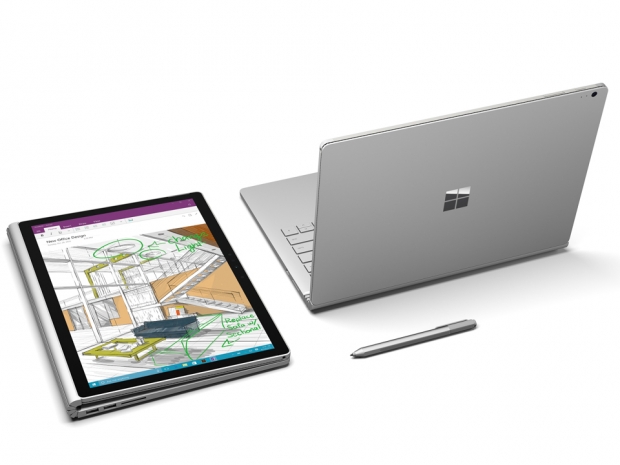The sources report the device will launch sometime after 2016, but do not specify whether design-related issues are hardware or software related. They they also confirm that the second-generation Surface Book will be upgraded from a 3000x2000p display to a 4K UltraHD (3840x2160p) display, perhaps in an effort to adopt a more industry-standard resolution that scales well across connected displays.
The second-gen Surface Book, or "Surface Book 2," will also feature at least one Thunderbolt 3 port based on Intel’s Alpine Ridge controller. This will provide up to 40Gbps of bi-directional bandwidth and the ability to daisy-chain up to six devices simultaneously – including up to dual 4K displays at 60Hz or a single 5K display (5120x2880p) at 60Hz.
Microsoft's original Surface Book design
The current Surface Book’s design was influenced by the variety of 2-in-1 convertible tablets that have hit mainstream retail shops since they emerged as an industry trend at the 2012 Consumer Electronics Show in Las Vegas. Microsoft developed a special hinge on the keyboard that would maintain the device’s weight-to-balance ratio, a move that allows the device to be used similarly to a clipboard and as a traditional notebook.
The Surface Book and Surface Pro series are both constructed using a magnesium metal “glass” that is melted in an oxygen-free environment and rapidly cooled to prevent crystallization. Of course, general chemistry tells us that magnesium catches fire when exposed to air. With this design, however, some claim the devices would need to be heated to between 500 and 600C to see any real effects, and these temperatures are far outside the rated device operating specs.
Perhaps Microsoft’s reported sign issues with the second-generation Surface Book have more to do with cosmetics, hinges and weight ratios than the construction material, but this is only an educated guess.
Current Surface Book Specifications
The current Surface Book, released in October 2015, measures 12.3 x 9.14 x 0.9 inches (312.4 x 232.2 x 22.9mm) and weighs 3.34 pounds (1.51kg) as a laptop, or just 0.3 inches thick (7.62mm) and 0.76kg (1.6 pounds) as a detachable tablet.
The device features a 13.5-inch 3000x2000p display (267ppi) and includes either a 2.4GHz Core i5 6300U (Skylake) or 2.6GHz Core i7 6600U (Skylake) CPU, 8 or 16GB of LPDDR3 RAM, an optional Geforce 940M 1GB GPU, 128GB to 1TB of SSD storage, dual-band 802.11n/ac Wi-Fi, Bluetooth 4.0, two USB 3.0 ports, a Mini DisplayPort, an SDXC card reader, an 8-megapixel rear 1080p camera, a 5-megapixel front camera, dual microphones, a 3.5mm headphone jack, and is compatible with a variety of stylus pens.
Surface Book vs. Surface Pro sales still unknown
In January, Microsoft reported that it sold 2.5 million Surface-series devices in Q4 2015 (October through December), or $888 million dollars’ worth. However, we are unsure how many of these sales are specifically Surface Book units versus Surface Pro 3 and 4 units. In total, the company sold 6 million Surface series devices in 2015. This is compared with a previous 4 million sale estimate for the year, according to sources in the upstream supply chain.




